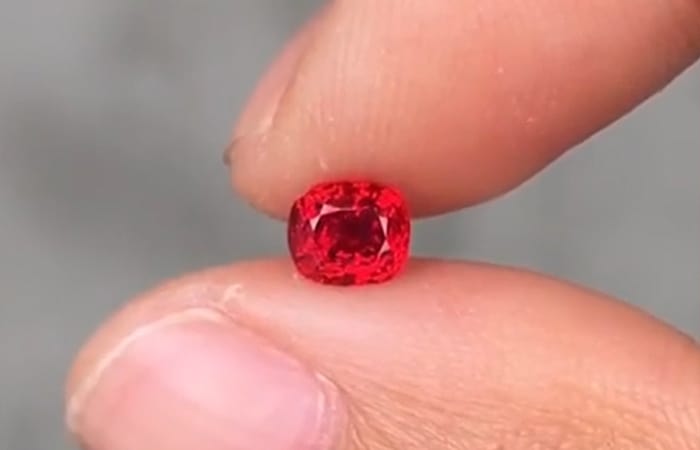Lab grown rubies have the same chemical, physical and optical properties as those found in nature. They are not treated in any way and are 100% natural. The only difference is that they are cultivated in a lab, as the name suggests. Some people might be concerned about their authenticity, but there is no need to worry. Lab grown rubies are real gemstones and they are the same as those found in nature.

How are Lab Grown Rubies Made?
Lab grown rubies, also known as synthetic rubies, are created in a laboratory setting through a process of high temperature and pressure. This process mimics the natural formation of rubies, which come from the mineral corundum.
By controlling the environment and ingredients used in the lab, growers can create a variety of colors and shades in their rubies. While not as valuable as mined rubies, lab grown stones offer an affordable option for those who want a ruby ring or necklace.
Advantages of Lab Grown Rubies
Lab grown rubies are created in a laboratory setting, where scientists carefully control the environment and all of the variables that affect ruby growth. This allows for near-perfect gems to be created, with little or no inclusions and amazing color. While natural rubies will always be prized for their rarity and beauty, lab grown rubies offer an affordable option for those who want a high-quality ruby without spending a fortune.
More Consistent in Color and Clarity than Natural Stones
Lab grown rubies are more consistent in color and clarity than natural rubies. This is because the conditions under which they are grown can be closely controlled, whereas natural rubies are formed under unpredictable conditions. Lab grown rubies also tend to be smaller than natural rubies, but this does not affect their quality or value.
Cheaper and Easier to Produce
Lab grown rubies are cheaper and easier to produce than natural rubies. The vast majority of rubies on the market are lab grown, and for good reason. They are much cheaper to produce than natural rubies, and they have essentially the same properties as their natural counterparts.
Lab grown rubies are made by growing a ruby crystal in a laboratory. This is done by heating up a piece of alumina (aluminum oxide) to over 2000 degrees Fahrenheit. The alumina is then placed in a crucible with a small amount of ruby dye, and left to cool. As the alumina cools, it forms a ruby crystal.
The process of growing a ruby crystal can be repeated multiple times, resulting in a large quantity of ruby crystals.
Environmentally Friendly
Lab grown rubies are environmentally friendly. They do not require mining or damaging gemstone-mining practices. Lab grown rubies are created in a laboratory, so there is no need for miners to disturb the earth’s surface to extract them.
In addition, since lab grown rubies are made from scratch, there is no need for damaging gemstone-mining practices like acid washing, which can pollute waterways and harm local communities.

Disadvantages of Lab Grown Rubies
When most people think of rubies, they think of the red gemstones that are so often associated with love and passion. What they may not know is that rubies can also made by scientists in a laboratory. While they share many of the same properties as natural rubies, there are some key disadvantages between the two types of gemstones.
Not Durable
Laboratory grown rubies are typically less durable than natural rubies. They are more likely to shatter or crack when they are hit or scratched. Natural rubies are more resistant to damage because their structure is more stable.
Not Valuable
One of the key factors that determines the value of a ruby is its naturalness. Lab-grown rubies are created in a lab using high heat and pressure, while natural rubies are mined from the earth. The creation process of lab-grown rubies results in mass production of the gemstone, which affects its value. Additionally, because lab-grown rubies are not as rare as natural rubies, they typically have a lower value.
How to Tell The Difference Between Lab Grown Rubies and Natural Rubies
Lab grown rubies are created in a laboratory by adding heat and pressure to a small piece of ruby crystal. Natural rubies, on the other hand, are formed when high temperatures and pressures cause corundum (a mineral made up of aluminum and oxygen) to crystallize from magma or lava. The physical, chemical, and optical properties of lab grown and natural rubies can be very different.
One way to tell the difference between a lab grown ruby and a natural ruby is by looking at their inclusions. Inclusions are tiny particles that get trapped in the ruby during its formation. Natural rubies often have inclusions that look like fingerprints, while lab grown rubies usually have inclusions that look like bubbles or circles.
Conclusion
In conclusion, lab grown rubies are real gemstones. They have the same optical and physical properties as natural rubies. Although they may not have the same monetary value as natural rubies, they are a beautiful and affordable alternative.



